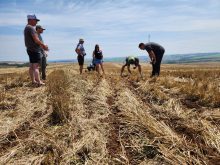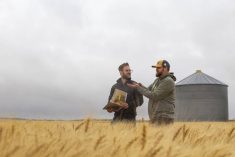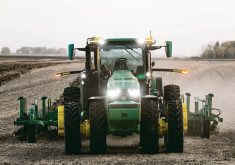Farming using only robots may sound like something out of the year 2050 — but the producers of a barley crop in the United Kingdom argue it’s here now.
Researchers at Harper Adams University in Shropshire, England, along with a U.K. precision ag company successfully grew a crop using only automated machines as their farmhands.
The “Hands-Free Hectare” pro-ject produced a 74-bushel-per-acre spring barley crop without ever having a human step foot on the field. Everything from planting, fertilizing, spraying, and harvesting was accomplished using small and simple machinery modified with automated technology.
Autonomous farming on a commercial scale isn’t far away, according to Jonathan Gill, a drone pilot and robotics engineer on the project.

“The adoption of automated systems is going to come a lot quicker than we anticipate,” Gill said at the Farming Smarter conference here last month, adding he expects to see farmers using the technology in five to seven years.
“Everybody thinks it’s way off into the future. I really wanted to show that the capabilities were there now.”
All of the programming on the equipment was done using software codes readily available through open-sourced communities on the internet. Within the hectare, several drones and a ground scout rover performed duties as agronomists. The drones whizzed around taking aerial imaging of the field, relaying valuable crop information back to the researchers.
“I’ve learned so much about how a drone system can work with agriculture,” said Gill. “It’s great because you can always go back to that imagery and data to quantify what you’ve seen.”

Drone imagery not only allowed the researchers to evaluate the growth of the crop and how the autonomous machines were doing, but also highlighted areas needing further inspection. That job was given to the ground scout rover, which could take close-up photos and also scoop up soil samples. A “real-life” agronomist would then get to work analyzing soil, weed, and plant root information along with the number of tillers found on the barley, said Gill.
“I think the agronomist in the future will be using more ground-based rover systems and drones to capture more data that they can analyze in a bunch, in comparison to just doing it by themselves,” he said.
Growing a small one-hectare crop autonomously certainly does not compare to how growers produce large-scale crops today, but Gill said he believes producers need to shift their mindset from big to small. Using fleets of smaller machines working together in swarms has advantages over today’s super-sized tractors, combines, and implements, he said.
Read Also

Farming Smarter receives financial boost from Alberta government for potato research
Farming Smarter near Lethbridge got a boost to its research equipment, thanks to the Alberta government’s increase in funding for research associations.
“This has some amazing benefits. You’ve got reduced compaction and improved resolution that actually allows us to have a margin gain.”
He pointed to the autonomous tractor system, which set them back about $60,000.
“Now I can buy a few good tractors — probably about nine — for the same price as one large system,” said Gill. “If I can run those together in a fleet, maybe I can actually start doing some interesting things around that.”
One of the biggest challenges for autonomous farming is communication capacity. Many rural areas lack the necessary Wi-Fi coverage that enables the autonomous equipment to communicate effectively.
“As soon as you’ve got that, we’ve got things nailed,” he said.
Although the adoption of autonomous farming will require a major shift in thinking in the agricultural industry, change is necessary because per-acre productivity must increase to feed a rapidly expanding global population, he said.
“The only way we can actually create the step change of increasing productivity within our farmland is by doing something different,” said Gill.
The Hands-Free Hectare researchers have now moved on to their next project (a winter wheat crop) and will be fine tuning their methods by collecting even more in-depth crop info to determine the best ways to increase yield.
To keep up to date on their progress, see handsfreehectare.com or follow them on Facebook (@HandsFreeHectare) or Twitter (@FreeHectare).















